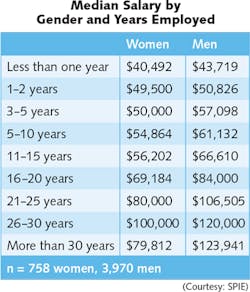
In the early 1990s, when I attended my first technical sessions at CLEO, I was not surprised that the audience was overwhelmingly male. That was a long time ago and, thankfully, there are many more women in the field now. But achieving gender balance is still a work in progress, even as evidence such as McKinsey’s 2018 Delivering through Diversity research shows that achieving gender, racial, and ethnic balance significantly improves corporate financial performance. One aspect of this gender imbalance is the difference in salaries between men and women over the course of a career in photonics.
Last month, I summarized the results of the 2019 Optics and Photonics Global Salary Report from SPIE. The news was fundamentally very good for individuals working in photonics, with many well-paying, satisfying careers. There was one disturbing summary point I quoted from the report, however. It was, “median salaries are 29% higher overall for men than for women, though gaps in median pay are smaller during early career stages.”
Confirming this trend, the 2018 IEEE-USA Salary Survey, the engineering world’s largest annual salary survey, found similar (actually worse) results regarding gender salary inequality. According to that survey, even when experience is factored in, female engineers earn median salaries $20,000 less than their male counterparts—up about $3500 from the previous year’s survey.
The salary inequality found in SPIE’s global survey does not have a simple explanation. But knowing some of the causes—such as women prioritizing child-rearing or eldercare—can help employers create flexible policies that attract and retain highly skilled and difficult-to-replace employees.
In 2017, the SPIE Gender Equity Task Force produced the very enlightening report: Gender Equity in the Optics + Photonics Workplace. Here are just a few of the report’s findings:
- Women’s representation in the workplace declines over time. At the earliest career stage, 21% of workers are women, but participation declines with increasing years on the job, dropping to 10% for employees with 30+ years at work.
- On average, men report working more hours per week than women, though there is very little gender difference in the highest-hour per-week categories.
- Women take mid-career breaks more often than men, with 69% citing childcare as a primary motivation vs. 9% of men.
- Women in the optics and photonics workplace are less likely to have children than men. This finding is particularly strong at mid-career stages, suggesting that many women leave the workforce after having children.
- Women take much more parental leave than men, with European and Asian women taking more time off than their North American colleagues.
“You have to understand that salary inequality is not a women’s issue, it’s a family issue,” says the Task Force chair, Julia Craven, who is principal member of the technical staff at Sandia National Laboratories and a board member of SPIE. “We treat the report data cautiously, but we’ve been motivated to collect it so we can make recommendations to the SPIE Board on efforts to effect change. The research is valuable, and we need to get everyone involved in this conversation.”
Optics and photonics companies such as Edmund Optics, FLIR, and Zemax are outspoken about their efforts to provide a flexible, supportive workplace and to benefit from a balanced corporate workforce. The issues are complex and salary equity is only one aspect, but a very important one.
“In the end,” says Craven, “we must convince people that correcting salary inequality is not altruism—it makes business sense.”
About the Author

Conard Holton
Conard Holton has 25 years of science and technology editing and writing experience. He was formerly a staff member and consultant for government agencies such as the New York State Energy Research and Development Authority and the International Atomic Energy Agency, and engineering companies such as Bechtel. He joined Laser Focus World in 1997 as senior editor, becoming editor in chief of WDM Solutions, which he founded in 1999. In 2003 he joined Vision Systems Design as editor in chief, while continuing as contributing editor at Laser Focus World. Conard became editor in chief of Laser Focus World in August 2011, a role in which he served through August 2018. He then served as Editor at Large for Laser Focus World and Co-Chair of the Lasers & Photonics Marketplace Seminar from August 2018 through January 2022. He received his B.A. from the University of Pennsylvania, with additional studies at the Colorado School of Mines and Medill School of Journalism at Northwestern University.
